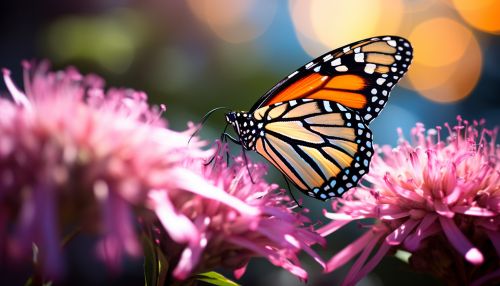Insect Migration
Introduction
Insect migration is a fascinating and complex phenomenon that involves the movement of insects from one habitat to another, often over long distances. This behavior is observed in a variety of insect species, such as monarch butterflies, dragonflies, and locusts, among others. The reasons for migration vary among species but often include changes in food availability, habitat, or weather.
Types of Insect Migration
There are two primary types of insect migration: complete and partial.
Complete Migration
Complete migration is characterized by the movement of an entire population from one location to another. This type of migration is often seasonal, with insects moving to take advantage of favorable conditions or to escape unfavorable ones. For example, monarch butterflies undertake a complete migration, traveling thousands of miles from North America to Mexico and back again each year.
Partial Migration
Partial migration, on the other hand, involves only a portion of the population migrating, while the rest remain in their original location. This type of migration is less well understood, but it is thought to be a strategy to maximize survival and reproductive success under varying environmental conditions.


Mechanisms of Insect Migration
Insect migration is a complex process that involves a variety of mechanisms, including navigation and orientation, flight behavior, and physiological adaptations.
Insects use a variety of cues to navigate during migration, including the sun, the earth's magnetic field, and landmarks. Some species, like the monarch butterfly, are even able to use a form of celestial navigation, orienting themselves using the position of the sun in combination with an internal biological clock.
Flight Behavior
Insects exhibit a range of flight behaviors during migration, from sustained, directional flight to more passive drifting with the wind. The type of flight behavior used often depends on the species and the environmental conditions.
Physiological Adaptations
Insect migration is also associated with a number of physiological adaptations. For example, migratory insects often have larger bodies and wings, and higher fat reserves, than non-migratory species. These adaptations help them to survive the long and often arduous journey.
Ecological and Evolutionary Implications of Insect Migration
Insect migration has significant ecological and evolutionary implications. It affects population dynamics, community structure, and ecosystem function, and it can also drive evolutionary change.
Population Dynamics and Community Structure
Migratory insects can have significant effects on population dynamics and community structure. They can act as predators, prey, or competitors, influencing the abundance and distribution of other species. They can also act as pollinators or seed dispersers, contributing to plant reproduction and the maintenance of biodiversity.
Ecosystem Function
Insect migration can also affect ecosystem function. For example, migratory insects can contribute to nutrient cycling by moving nutrients from one location to another. They can also influence primary production and decomposition processes.
Evolutionary Change
Insect migration can also drive evolutionary change. It can lead to the evolution of new traits, such as increased body size or wing length, or changes in life history strategies. It can also lead to the formation of new species, a process known as speciation.
Threats to Insect Migration
Insect migration is threatened by a variety of factors, including habitat loss, climate change, and human activities. These threats can lead to declines in migratory insect populations, with potential impacts on biodiversity and ecosystem function.
Habitat Loss
Habitat loss is a major threat to migratory insects. Many species rely on specific habitats for breeding, feeding, or overwintering, and the loss of these habitats can have significant impacts on their populations.
Climate Change
Climate change is another significant threat to insect migration. Changes in temperature, precipitation, and other climatic factors can affect the timing, route, and success of migration. For example, warmer temperatures can lead to earlier spring migration, which can result in mismatches with food availability or breeding conditions.
Human Activities
Human activities, such as pesticide use, pollution, and the introduction of invasive species, can also threaten insect migration. These activities can directly kill migratory insects or degrade their habitats, making migration more difficult or even impossible.
Conclusion
Insect migration is a complex and fascinating phenomenon with significant ecological and evolutionary implications. However, it is also under threat from a variety of factors, including habitat loss, climate change, and human activities. Understanding and addressing these threats is crucial for the conservation of migratory insect species and the ecosystems they support.
